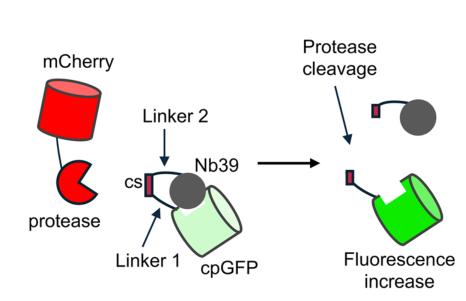SPOTIT-A genetically encoded multifunctional fluorescent sensor
In recent years, fluorescent biosensors have played an increasingly important role in biological research, particularly in detecting cellular signaling molecules and events. Among them, genetically encoded fluorescent sensors based on fluorescent proteins have garnered significant attention due to their ability to readout cellular processes with high spatial resolution and cell-type specificity. Among the myriad of fluorescent sensors, the SPOTIT series stands out for its high versatility and functionality. This series includes sensors such as SPOTIT for detecting opioid molecules, SPOTon for detecting protease activity, protein-protein interactions, and opioid molecules with temporal gating, and SPOTall for detecting other GPCR ligands.
The current study further functionalizes the SPOTIT series of sensors and demonstrates their extensive applications in protease activity detection and G protein-coupled receptor (GPCR) ligand detection. The research team first optimized the protease detection motif to develop the Mpro-SPOTon sensor, capable of detecting the activity of the coronavirus main protease (Mpro), and validated its effectiveness in animal models. Additionally, by utilizing doxycycline (Dox)-induced protease expression, a novel protease-based time-gating mechanism was developed to enable temporally controlled detection of opioids. This innovative method has the potential to be generalized to other similar sensors, improving the temporal resolution of GPCR ligand detection.

Hotspots:
- Functionalization and Diversification of Fluorescent Biosensors: With the deepening of biological research, the demand for fluorescent biosensors has also become more diversified. Improving the sensitivity and specificity of sensors through functionalization, as well as expanding their range of applications, is a current research hotspot.
- Roles of Proteases and GPCR Ligands in Disease: Proteases and GPCR ligands play crucial roles in the onset and progression of various diseases. Therefore, the development of efficient and accurate fluorescent biosensors for detecting these molecules is of significant importance for disease diagnosis and treatment.
- Application of Time-Gating Techniques in Fluorescent Sensors: Time-gating techniques can improve the temporal resolution of fluorescent sensors, enabling more accurate recording of the dynamic changes of biomolecules. The application of this technology in fluorescent sensors is another current research hotspot.
Research Controversies
- Sensitivity and Specificity of Sensors: Although fluorescent biosensors have made significant progress in detecting biomolecules, their sensitivity and specificity still need improvement. In particular, enhancing the anti-interference ability of sensors in complex biological samples is a major challenge.
- Scope of Sensor Applications: Different fluorescent biosensors have varying scopes of application. Choosing the appropriate sensor based on specific research needs and functionalizing it when necessary is another point of controversy in current research.
Future Directions
- Enhancing Sensor Sensitivity and Specificity: By optimizing the sensor structure and performance, such as introducing new fluorescent groups and improving signal conversion mechanisms, the sensitivity and specificity of sensors can be further improved.
- Expanding Sensor Applications: Developing fluorescent biosensors with specific functions tailored to the detection needs of different biomolecules, and expanding their application range in disease diagnosis, drug screening, and other fields.
- Integrating Emerging Technologies to Enhance Sensor Performance: Combining artificial intelligence, big data, and other emerging technologies to analyze and process data from fluorescent biosensors, improving their resolution and detection efficiency. Meanwhile, leveraging micro-nano scale fabrication technologies to promote sensor applications in medical diagnosis, environmental monitoring, and other fields.
- Promoting Standardization and Commercialization of Fluorescent Biosensors: Establishing a standardized system for fluorescent biosensors to promote their widespread use in scientific research and clinical practice. Additionally, strengthening collaboration with industries to drive the commercialization process of fluorescent biosensors, providing more high-quality products for biomedical research and clinical applications.
In summary, research on fluorescent biosensors for protease and GPCR ligand detection has made significant progress, but still faces many challenges. In the future, with continuous technological advancements and innovations, fluorescent biosensors are expected to play an increasingly important role in biomedical research and clinical applications.
Reference
- Sescil J, Fiel H, Havens SM, Fu E, Li X, Kroning KE, Solowiej I, Li P, Wang W. Functionalization of a versatile fluorescent sensor for detecting protease activity and temporally gated opioid sensing. RSC Chem Biol. 2025 Feb 18. doi: 10.1039/d4cb00276h. Epub ahead of print. PMID: 39975583; PMCID: PMC11835013.
Contact us or send an email at for project quotations and more detailed information.
Quick Links
-

Papers’ PMID to Obtain Coupon
Submit Now -

Refer Friends & New Lab Start-up Promotions

